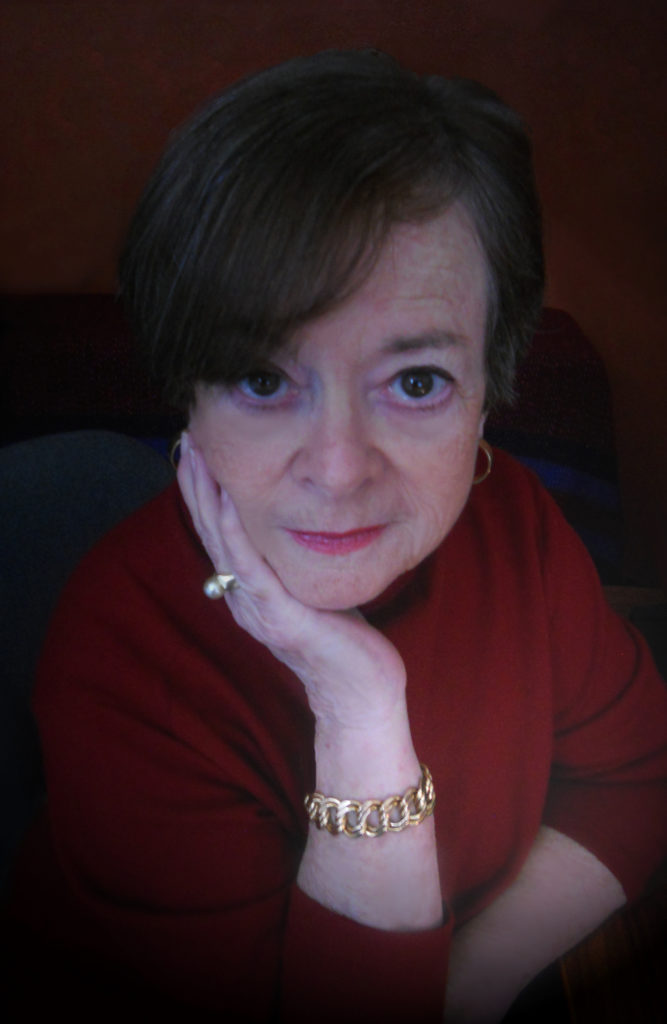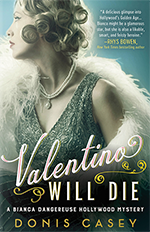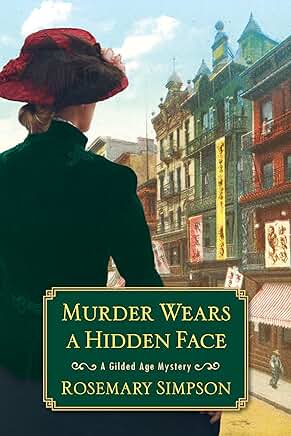
I am honored to welcome historical mystery author Rosemary Simpson as my December Tell Me Your Story guest. Rosemary is the author of the wonderfully evocative Gilded Age Mystery Series, as well as The Seven Hills of Paradise and Dreams and Shadows. She is a member of Sisters in Crime, International Thriller Writers, and the Historical Novel Society. Educated in France and the United States, she now lives near Tucson, Arizona and can be found online at RosemarySimpsonBooks.com. Rosemary’s eighth Gilded Age Mystery is Murder Wears a Hidden Face. Do yourself a favor and take a trip back in time with Rosemary.
Why Historical Fiction?
I don’t remember the first time I spent a winter holiday flat on my back in bed with tonsillitis, but it got to be a recurring theme as I grew up. Cold weather, a sore throat, antibiotics, apple juice, homemade chicken soup, and finally, at the end of the day, a whiskey toddy to help me sleep. I don’t know how other teenagers spent their Christmas vacations, but that’s how I enjoyed mine. No idea why my tonsils were never taken out—I just suffered with them year after year after year.
The one bright spot in the annual tonsillitis marathon was the bag of books my mother brought me from the library. In our household, whenever illness threatened, a library run was considered as indispensable as a trip to the doctor’s office or the drugstore.
I devoured that book. It opened the medieval world to me in a way that no history course ever could. I read everything Anya Seton wrote, but KATHERINE always remained my favorite. To this day I can walk over to my bookshelf and pick up my most recent copy, start to read, and be lost in the fourteenth century for hours. Days. It’s the type of novel you don’t put down. You read it cover to cover and sigh regretfully when you finish. Nothing else could possibly ever be that good.
From KATHERINE I progressed through the novels of Thomas B. Costain, Mary Renault, Pearl S. Buck, Howard Fast, Margaret George, E.L. Doctorow, Ken Follett, and others too numerous to name. Hilary Mantel, Sharon Kay Penman, and Bernard Knight in more recent years. Though the European Middle Ages has always remained my favorite place and time, these and so many other writers of historical fiction took me all over the world, from Jean M. Auel’s depiction of the European Upper Paleolithic era to Alex Haley’s odyssey through the pre-Civil War American South.
I made only two demands on the historical fiction I read. The narrative had to be true to the historical reality of the period in which the novel was set, and the characters couldn’t be twentieth century mock-ups of their real-life predecessors. Historical romance was out. So were works of alternate history. Whatever I read had to be honest and real—or I never again read another book by that author.
So when it came time for me to write my first book, it had to be—drum roll, please—historical fiction. I never considered anything else.
I was neck deep in medieval studies at the time, finishing a degree in medieval French historiography, i.e., the story of how history is written and interpreted. Not so much the facts as what real people experience and how they choose to document their fates. I happened to be taking a seminar in French chronicles, which led me naturally to the two most famous accounts of the Fourth Crusade, one written by Jean Froissart, who was among the leaders of the crusade, the other dictated by Robert de Clari, an ordinary knight who survived the expedition and made it back to Picardy in one piece. It took no time at all to decide who should be the hero of the book. It had to be Robert de Clari, of course. THE SEVEN HILLS OF PARADISE (Doubleday) was the result.
I wrote my second historical novel based on the stories I was told by an aunt with whom I spent weekends in Paris while attending boarding school in a suburb of the city. The Eiffel Tower could be glimpsed through the trees growing along the quay, the Seine flowed beneath the balcony on which we sat, cigarette smoke drifted on the afternoon breeze, and champagne loosened the tongue of this woman who had spent the Nazi Occupation hiding her American citizenship and fearing that her husband would be picked up by the Gestapo because he was a Jew. DREAMS AND SHADOWS (St. Martin’s Press) wasn’t entirely their story, but some of the tales I heard on that balcony made their way into the creation of characters who were fictional—with perhaps now and then a trace of something akin to truth.
The Gilded Age Mysteries I write for Kensington Books came about because of a snowstorm. I was desperately in search of a time and place for a heroine who was hovering behind my shoulder, nagging me to put her on a page—any page—when I read in the New York Times archives about the Great Blizzard of 1888. Hundreds of people dead. Limbs sticking up out of snowdrifts. Trains stuck on tracks. Telephone and electricity poles toppled into the streets of America’s biggest city. That was it! Where better to hide a corpse than in a shoulder-high pile of snow? I wrote the novel, WHAT THE DEAD LEAVE BEHIND, submitted it to an agent, did the revisions she requested, and prepared to wait while it went out on submission. It sold within a couple of days. I recently turned in the manuscript for the ninth book in the series, DEATH TAKES THE LEAD, which will be published in November 2024.
History and crime combined. What could be better? Famous crimes and criminals of the past are endlessly fascinating. That’s one of the reasons true crime books about people like Leopold and Loeb, Geoffrey Dahmer, John Wayne Gacy, and Ted Bundy always sell. Not to mention Al Capone, Jesse James, and Charles Manson. Nero. Caligula. There’s no end to the list.
Wading into the world of historical crime fiction is perhaps one of the most rewarding things I’ve done during my writing career. Brother Cadfael welcomed me, as he has many other writers. Edith Pargeter, writing as Ellis Peters, brought him to life—a medieval monk—and placed him squarely in the path of one dastardly villain after another. Without leaving his monastery. Anne Perry taught us how to keep several series going simultaneously; we marveled at how she swiveled easily between them.
I think it’s time I let you go. Back to whatever book you’re reading now. I hope you’re enjoying it. I trust it takes you out of yourself and drops you into someone else’s skin. For as long as there are pages beneath your fingers.
And I invite you into the world of historical fiction. Historical crime novels. Historical noir. Which is where I live. Come join me. Open a book. Drink a cup of tea. Let go of today’s troubled world.
Until we meet on a page. Au revoir.
________________




More Places to Go
Donis on Facebook
Type M for Murder